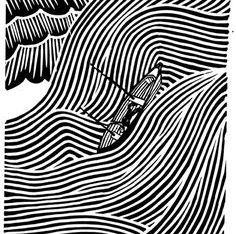 By Daniel SOUKUP
By Daniel SOUKUP
An overview of classroom situations
Dr Daniel Soukup (1976) is graduated in English, German, Czech Literature and Literary Theory from Charles University (Prague, Czech Republic). Since 2002, he has been teaching at Josef Skvorecky Literary Academy (Prague); since 2010, he has been the university’s vice-rector for international relations. In 2005, he was one of the founders of the European Network of Creative Writing Programmes, becoming its first coordinator (2005–2010), and then vice-president of the follow-up European Association of Creative Writing Programmes (since 2010). He has published translations, original poetry and academic articles.
The one obvious obstacle which sometimes bars the way to fruitful European cooperation in the field of Creative Writing is the bewildering multitude of languages. In theory, we can only approve of our wonderfully rich linguistic diversity; but in our everyday dealings, we all too often have to struggle with the practical problems arising from it. As it is sometimes difficult to understand each other even about the most straightforward matters, teaching writing in a foreign language might seem a sheer impossibility. Nevertheless, experience shows that there is, in fact, quite a wide terrain of opportunity between the abstract ideal of multilingualism, and the frequent exasperation of not being able to communicate: creative writing students and teachers who speak different languages do meet, interact, and learn from each other.
In this paper, I would like to introduce the most typical classroom situations that involve a foreign language element, and outline some of the challenges which characterize them. Most of the concrete examples come from my own practice, because I do not feel confident enough to speak in detail about other people’s teaching. However, my aim is to provide a simple matrix which might serve to systemize the experience of other teachers and students, too.
In the following overview, the language which students use in their writing is called X. Apart from this, there are three other languages to consider: the language of instruction; the teacher’s first language; and the students’ first language. Of course, two or three of these languages might be (and usually are) identical. I leave out the case of a bilingual or multilingual teacher; but I do consider the possibility of a linguistically mixed student group.
This overview does not contain all the combinations which are logically possible, but only the most typical ones. In fact, it seems unlikely that any of the logically possible situations which are not listed here might ever occur in reality; for instance, the idea of a Czech teacher explaining, in Czech, to a group of Finnish students how to write in Finnish (pattern XAAX) sounds quite bizarre. But one can never predict with confidence what linguistic mishmashes life might bring, particularly in Europe.
Apart from the languages used, the other aspect which I look at is the overall aim of teaching writing in a foreign language; of course, this aim might differ in different classroom situations. In order to systemize pedagogical experience, I use the typology of attitudes towards Creative Writing outlined by Paul Dawson in his book Creative Writing and the New Humanities. According to Dawson, “Creative Writing is the product of four institutional trajectories – each with particular theories of literature, authorship and pedagogy that sometimes conflict and sometimes overlap. I will label these trajectories creative self-expression, literacy, craft and reading from the inside.” (Dawson 2005: 49). He summarizes these approaches as follows:
Creative self-expression is a technology of the self whereby language (especially through the medium of poetry) is a device for discovering and developing the expressive potential of one’s own human character. The literacy model situates “creative” writing within a general writing instruction which trains students for competency in a variety of compositional modes for the purposes of accurate expression and professional communication. The craft model involves the conjunction of formalist criticism with the concept of artistic training associated with the fine arts. Reading from the inside is founded on the belief that practical experience in writing literature leads to a greater knowledge and appreciation of it. (ibid: 49)
Naturally, the application of Dawson’s interpretive labels is less objective and less generally valid than the lists of languages used; ultimately, the overall teaching aim always depends on the particular course.
 Situation 1: A Czech teaches Czechs to write in English
Situation 1: A Czech teaches Czechs to write in English
Language of writing: X
Language of instruction: X and/or A
Teacher’s first language: A
Students’ first language: A
Of all the situations listed here, this one is the least relevant to international cooperation in Creative Writing, because the teacher and the students share the same first language. The only international element is the foreign language used for writing, and sometimes also for instruction. But I do not believe in sharp dividing lines, and it seems to me that all the various approaches to teaching writing in a foreign language might inspire and enrich each other.
Rather than in the Creative Writing context, this configuration typically occurs in foreign language teaching, which classifies writing as one of the four “basic skills” (with reading, speaking and listening). Teaching writing from this perspective can – and often does – involve creative exercises, too. The most commonly used genres seem to be the narrative ones, because story-telling, as an obvious human universal, helps to bridge linguistic and cultural gaps. But one can make a strong case also for using forms which are perceived as more difficult, notably poetry.
For instance, a textbook focusing on “reading and writing poems with students of English” lists a number of different reasons “why use poetry to learn English”: 1) “poetry is a special type of English, just as scientific or newspaper English […]; it deserves study as much as they do”; 2) “poetry can […] help us to assimilate the typical rhythms of a language”; 3) “poems are often very easy to remember”; 4) “the topics which poems talk about are in themselves interesting – and important”; 5) “the process of composing poems, especially if it is done in groups, leads to real discussion, about something that matters to you”; 6) “[writing poems] allows you to try out different ways of saying the same thing”; 7) “[writing poems] gives you a purpose in writing, and allows you to bring in your personal feelings and ideas”. (Maley and Moulding 1985: 1)
As another author says, sometimes we might even write “better in a language that is not our first […]. We write simply and to the point and are more aware of the sounds of the new language because they are strange and wonderful to us. We avoid clichés because probably we do not know them so well.” (James 2007: 13)
Some literary genres and traditions are particularly suitable for language education. For instance, experimental “concrete poetry” is often used in German language teaching, because it opens up space for playful linguistic creativity, while also familiarizing students with the typical patterns of the German language. Moreover, one can compose interesting concrete poems in a foreign language even without being very good at it, which is highly motivating.
In terms of Dawson’s typology, this classroom situation clearly falls under the literacy model, with some elements of creative self-expression (“bringing in your personal feelings and ideas”). Besides, reading from the inside can be employed, too.
 Situation 2: An American teaches Czechs (and others) to write in English
Situation 2: An American teaches Czechs (and others) to write in English
Language of writing: X
Language of instruction: X
Teacher’s first language: X
Students’ first language: A (B, C…)
This situation, like the previous one, often occurs in foreign language teaching, but it is not limited to it. Here I cannot speak from my own experience, because there do not seem to be many international students who are keen on learning to write in my first language (Czech). Nevertheless, I can still give a few general observations. Obviously, the teacher in Situation 2 (who teaches in his first language) has a great advantage over the teacher in Situation 1 (who teaches in a foreign language). In fact, if one of the main aims of the class is to improve the students’ writing skills, a native teacher is probably preferable over a non-native one. Therefore, for instance, at the Josef Skvorecky Academy, the optional seminar “Creative Writing in English” (for Czech students) has been taught only by native speakers.
With the teacher being a native speaker, the overall teaching aim might be based not only on the literacy approach (“general writing instruction”), but also on the craft model: teaching foreign students to produce, for instance, “well-written” short stories. However, if the teacher has experience only with teaching writing to native speakers, she might find it quite difficult to adjust her expectations to foreign students; she might tend either to underestimate, or to overestimate their achievements. Another possible drawback of this classroom situation might arise from the fact that, by its very nature, it gives the teacher almost too much symbolical power: she possesses pedagogical and social authority (as a teacher), linguistic authority (as a native speaker), and often also aesthetic authority (if she is also a writer).
 Situation 3: A Czech teaches Finns (and others) to write in English
Situation 3: A Czech teaches Finns (and others) to write in English
Language of writing: X
Language of instruction: X
Teacher’s first language: A
Students’ first language: B (C, D…)
An example of this classroom situation is the workshop Understanding and writing (short) stories which I taught in September 2012 at the University of Jyväskylä (Finland). Before the class, I asked the students to read Joseph Conrad’s Heart of Darkness, selected short stories by James Joyce (from Dubliners), and selected short stories by the Canadian writer Alice Munro (from her book Progress of Love) – a heterogeneous mixture which made use, pragmatically, of books which the students had to read anyway for another course. There were three classes, one on the work of each writer. The student group was quite varied, consisting of both Finnish and international students. It even included one Czech and one American, so the catalogue of students’ first languages should, strictly speaking, include not only “B, C, D…”, but also “A” and “X”.
With the reading list being so diverse, I used a simple, generally applicable approach, and asked the students to consider the following elements of the stories they read: a) characters, b) plot, c) setting, d) atmosphere, e) emotions, f) style, g) cultural references, and h) the overall meaning. Each class concentrated on two or three of these elements; we discussed, for instance, the overall meaning of Heart of Darkness (issues of allegory); stylistic ruptures in Joyce’s short story The Dead; or Alice Munro’s depiction of characters. Each line of discussion was concluded with a short writing exercise.
Using Dawson’ typology, we could say that this workshop combined elements of the craft model and reading from the inside.
 Situation 4: A Czech teaches Austrians to write in German
Situation 4: A Czech teaches Austrians to write in German
Language of writing: X
Language of instruction: X
Teacher’s first language: A
Students’ first language: X
This situation is pedagogically interesting because it puts the teacher clearly at a disadvantage: he/she, as a non-native speaker, teaches native speakers to write in their own language. In this configuration, the teacher might actually be better placed to learn something about writing from the students; but still she, being a teacher, must be able to discover something to teach them. What could it be? Unless the teacher is very proficient in the foreign language, she will find it difficult to employ Dawson’s literacy model, and will be able to make only limited use of the craft approach.
An example of this classroom situation is the workshop Czech-German translations (part “Kingdom of Bohemia”) which I taught in Vienna in May/June 2012 (it was organized jointly by Vienna poetry school and University of Applied Arts). The workshop consisted of three sessions. The first language of all the students was German, though not all of them were Austrians; one came from South Tirol, and one actually had a Czech family background. The workshop consisted of four classes and a final public presentation.
When musing about what to offer to students whose language I speak only imperfectly, I decided to concentrate on the long history of Czech-Austrian relations. Since 1526, we lived together in the Habsburg Monarchy; and even after its dissolution in 1918, there was a strong German-speaking minority in Czechoslovakia, until most of them were expelled after World War II. The class did not provide a comprehensive historical overview, but it was primarily creative, introducing various linguistic, historical and cultural fragments of the past Czech-Austrian coexistence in ways which were meant to enable students to make imaginative use of them. One source of inspiration was the novel The Flight to Egypt (Die Flucht nach Ägypten) by Otfried Preußler (1923), a German-speaking writer born and raised in Bohemia, and expelled by Czechs after WWII.
I find it difficult to classify this workshop in terms of Dawson’s typology. One could probably say that it was a blend of creative self-expression, craft and reading from the inside, but with a strong cultural component which interconnected all these approaches.
On the other hand, some of the discussions and exercises did not revolve around culturally specific Czech-Austrian-German issues, but focused on more general questions, such as the role of memory in constructing identity, or on specific stylistic devices. The three texts which students read at the concluding public presentation represented these divergent aspects of the class: one text came out of the exercise the story and the story-teller hunt each other (based on the narrative technique of Preußler’s novel); the second student wrote an essaystic reflection inspired by a few lines by the Irish poet Seamus Heaney: “Memory as a building or a city, / Well lighted, well laid out, appointed with / Tableaux vivants and costumed effigies” (Heaney 1991: 75); and the third student wrote the imaginary life story of two anonymous figures in a photograph, probably mother and son.
This is a photograph I found in an old house in one of the Czech border regions which were formerly populated by the German-speaking community. Re-inventing their long-forgotten life story is a way to restore, at least in a fleeting moment of imagination, something which was crushed by the brutal forces of history. This example also shows that when there is a shared cultural background, work with “found objects” might give writers – and writing teachers – a whole range of impulses across languages and cultures. For instance, the Czech poet Radek Fridrich collects German grave inscriptions in old churchyards in Czech border regions, and uses them in his writing. Here is an example:
Fragment
Anna
geb.
Wirtschaftsb
gest. 6.
im 48. L
Gatt nub
und
Josef
edin
Septemb
68. Lebensj
(Fridrich 2002)
This poem, obviously a verbatim transcription of a half-destroyed grave inscription, is all in German, and yet it appears in a Czech collection by a Czech poet. In an inconspicuous way, it speaks volumes about historical memory, national identity and nostalgia, while also indicating the scope of possibilities of what it might mean to “write in a foreign language”.
As his last project, Christian Ide Hintze, the Austrian poet and founder of Vienna poetry school, worked on what he called “7fold poetics”, integrating traditional, literary poetry with other types of poetry (acoustic, visual, performative, interactive, infrastructural, and instructive). His ideas included moving away from the exclusive focus on “a national & standardized language”, and away from the effort to “find truth” only “by carefully following the black & the white of the letters & the spaces in between them.” (Hintze 2010; see also the project website: www.ide7fold.net)
Teaching writing in a foreign language also seems to work best when it does not focus exclusively on literary aspects, but involves, for instance, performative or intercultural elements, too. An example of this are successful drama workshops for Finnish and Czech students which took place at the Literary Academy. The language of both instruction and writing was English, and the workshops were co-taught by Harri István Mäki (Orivesi College of Arts) and a native creative writing teacher (Joanna Coleman and Brad Vice).
In addition, Ide Hintze’s visionary “7fold poetics” is in line with concepts like hybridization which are gaining more and more weight in our increasingly intercultural world. Two examples will illustrate what impact this might have on writing. In her book on “literature between the cultures”, Sabine Scholl quotes from the seminal book Borderlands/La Frontera:
The New Mestiza (1987) by the Mexican-Texas author Gloria Anzaldúa:
To live in the Borderlands means you
are neither hispana india negra española
ni gabacha, eres mestiza, mulata, half-breed
caught in the cross-fire between camps
while carrying all five races on your back […];
To live in the Borderlands means to
put chile in the borscht,
eat whole wheat tortillas,
speak Tex-Mex with a Brooklyn accent […]. (Scholl 1999: 59–60)
Scholl notes parallels between the geographical borderlands (the Mexican-Texas border), the body and the consciousness of “the new mestiza”, as well as the stylistic texture of Anzaldúa’s book: they are all marked by similar heterogeneity. (ibid.: 61)
Margaret Anne Clarke uses the same metaphor in her article “Creative Writing in the Borderlands” which analyzes student texts written for the Creative Writing in a Foreign Language competition at the University of Portsmouth. Clarke sees writing in a foreign language as a way of overcoming the traditional concept of the “native speaker”, used as
“the yardstick against which the language learner […] must gain enough competence to attain the ideal of the still imperfect ‘near-native speaker’.” In an increasingly globalized world, this elitist and monoglossic concept of language learning seems dated, and so does the idea of “a homogenous or monolithic entity representing the ‘official’ language of one nation-state.” In language teaching, “the focus is no longer on the learning by students about a separate language and culture located on the other side of a national frontier, but on the heteroglossic third space emerging within the consciousness of the language learners themselves.” When writing in a foreign language, “the language learner is […] actively participating in her chosen speech community, and is actively contributing to the transformation of language within that community.” (Clarke 2008)
The most significant aspect of this linguistic “third space” may be the fact that, as Clarke mentions, it is based on choice; writing in a foreign language is not open only to “new mestizas” or to Czech poets living in regions full of old German cemeteries. All of us are free to start learning any language, and to make use of its words in our teaching and writing.
Bibliography
Anzaldúa, Gloria (1987): Borderlands/La Frontera: The New Mestiza. San Francisco: Aunt Lute Books.
Clarke, Margaret Anne (2008): “Creative Writing in the Borderlands”. http://www.academia.edu/412837/Creative_Writing_in_the_Borderlands (access 4 Nov 2012).
Dawson, Paul (2005): Creative Writing and the New Humanities. London and New York: Routledge.
Fridrich, Radek (2002): Erzherz. Olomouc: Votobia.
Heaney, Seamus (1991): Seeing Things. London: Faber and Faber.
Hintze, Christian Ide (2010): “poetry in times of transition. 7fold poetics”. paper for the 2nd international conference on creativity and writing, orivesi, finland, 19–22 Nov 2010.
James, Gill (2007): “Thinking outside the box: Creativity in language learning”. In: Toungefreed 2006/07. Creative Writing in a Foreign Language. University of Portsmouth.
Maley, Alan and Sandra Moulding (1985): Poem into Poem. Reading and writing poems with students of English. Cambridge: Cambridge University Press.
Preußler, Otfried (1991): Die Flucht nach Ägypten. Königlich böhmischer Teil. Stuttgart – Wien – Bern: Thienemann.




